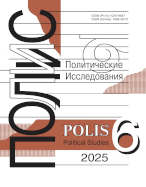International norms in the face of technological change:
challenges for constructivist theory of arms control
Istomin I.A.,
MGIMO University, Moscow, Russia, i.istomin@inno.mgimo.ru
elibrary_id: 333124 | ORCID: 0000-0002-8334-6343 | RESEARCHER_ID: A-8494-2017
Crowley-Vigneau A.,
MGIMO University, Moscow, Russia; University of Reading, Reading, UK, vigneau.a@my.mgimo.ru
elibrary_id: 1090824 |
Article received: 2023.02.06. Accepted: 2023.05.10

DOI: 10.17976/jpps/2023.04.02
EDN: UAPADM
Istomin I.A., Crowley-Vigneau A. International norms in the face of technological change: challenges for constructivist theory of arms control. – Polis. Political Studies. 2023. No. 4. https://doi.org/10.17976/jpps/2023.04.02. EDN: UAPADM
The authors are deeply indebted William C. Wohlforth, Irina Bolgova, Alexander Chekov, Ivan Fomin, Christopher Korten, Nikolay Silaev, Maxim Suchkov and Andrey Sushentsov for their kind comments, suggestions and criticism.
The emergence, diffusion and internalization of international norms face underestimated challenges in the sphere of arms control, which attempts to regulate and restrict the development and use of weapons. We explore the concept of uncertainty and reveal how it sets arms control apart from some other spheres that have experienced a rapid development and consolidation of international norms. The dynamic nature of technological change creates expectations of revolutionary novelty and perceptions of radical uncertainty, which run against some of the main mechanisms supporting international norms including grafting, strategic bargaining and moral consciousness raising. An original qualitative case study on norms related to the prohibition of biological weapons confirms that overcoming uncertainty is particularly difficult in arms control and that norms regulating weapons remain fragile after their institutionalization, due to ever-evolving technological change.
References
Acharya, A. (2004). How ideas spread: whose norms matter? Norm localization and institutional change in Asian regionalism. International Organization, 58(2), 239-75. https://doi.org/10.1017/S0020818304582024
Ali, R. (2009). Technological neutrality. Lex Electronica, 14(1). https://www.lex-electronica.org/files/sites/103/14-2_ali.pdf
Arbatov, A. (2019). Mad momentum redux? The rise and fall of nuclear arms control. Survival, 61(3), 7-38. http://dx.doi.org/10.1080/00396338.2019.1614785
Beard, J. M. (2007). The shortcomings of indeterminacy in arms control regimes: the case of the biological weapons convention. American Journal of International Law, 101(2), 271-321. https://doi.org/10.1080/00396338.2019.1614785
Brooks, L.F. (2020). The end of arms control? Daedalus, 149(2), 84-100. http://dx.doi.org/10.1162/daed_a_01791
Bull, H. (1977). The anarchical society: a study of order in world politics. London: Macmillan.
Buzan, B. (2004). From international to world society? English school theory and the social structure of globalisation. Cambridge: Cambridge University Press.
Carpenter, R.C. (2011). Vetting the advocacy agenda: network centrality and the paradox of weapons norms. International Organization, 65(1), 69-102. https://doi.org/10.1017/S0020818310000329
Carpenter, R.C. (2007). Setting the advocacy agenda: theorizing issue emergence and nonemergence in transnational advocacy networks. International Studies Quarterly, 51(1), 99-120. https://doi.org/10.1111/J.1468-2478.2007.00441.X
Checkel, JT. (2017). Socialization and violence: Introduction and framework. Journal of Peace Research, 54(5), 592-605. https://doi.org/10.1177/0022343317721813
Cooper, N., & Mutimer, D. (2011). Arms control for the 21st century: controlling the means of violence. Contemporary Security Policy, 32(1), 3-19. http://dx.doi.org/10.1080/13523260.2011.556820
Dellapenna, J.W. (1999). Law in a shrinking world: The interaction of science and technology with international law. Kentucky Law Journal, 88(4), 809-83. https://conservancy.umn.edu/bitstream/handle/11299/156342/ahc_asset_365988.pdf?sequence=1
Epstein, C. (2012). Who speaks? Discourse, the subject and the study of identity in international politics, European Journal of International Relations, 17(2) (2011), 327-50. http://dx.doi.org/10.1177/1354066109350055
Finnemore, M., & Sikkink, K. (1998). International norm dynamics and political change. International Organization, 52(4), 887-917. https://doi.org/10.1162/002081898550789
Haas, P.M. (1989). Do regimes matter? Epistemic communities and Mediterranean pollution control. International organization, 43(3), 377-403. https://doi.org/10.1017/S0020818300032975
Hanson, M. (2018). Normalizing zero nuclear weapons: The humanitarian road to the Prohibition Treaty. Contemporary Security Policy, 39(3), 464-86. https://doi.org/10.1080/13523260.2017.1421344
Hatch, B.B. (2018). Defining a class of cyber weapons as WMD: an examination of the merits. Journal of Strategic Security, 11(1), 43-61. https://doi.org/10.1080/13523260.2017.1421344
Holmes, E.C., Goldstein, S.A., Rasmussen, A.L., Robertson, D.L., Crits-Christoph, A., Wertheim, J.O., & Rambaut, A. (2021). The origins of SARS-CoV-2: a critical review. Cell, 184(19), 4848-4856. https://doi.org/10.1016/j.cell.2021.08.017
Jervis, R. (1978). Cooperation under the security dilemma. World Politics, 30(2), 167-214. https://doi.org/10.2307/2009958
Kalpokienė, J., & Kalpokas, I. (2020). Contemplating a cyber weapons convention: an exploration of good practice and necessary preconditions. Baltic Journal of Law & Politics, 13(1), 51-80. http://dx.doi.org/10.2478/bjlp-2020-0003
Katzenstein, P.J. (Ed.) (1996). The culture of national security: norms and identity in world politics. New York, NY: Columbia University Press.
Keck, M.E., & Sikkink K. (1998). Activists beyond borders: advocacy networks in international politics. Ithaca: Cornell University Press.
Koops, B.-J. (2006). Should ICT regulation be technology-neutral? In B.-J. Koops, M. Lips, C. Prins, & M. Schellekens (Ed.), Starting Points for ICT Regulation. Deconstructing Prevalent Policy One-Liners, IT & Law Series (pp. 77-108). Hague: T.M.C. Asser Press.
Kutz, C. (2014). How norms die: Torture and assassination in American security policy. Ethics & International Affairs, 28(4), 425-449. https://doi.org/10.1017/S0892679414000598
Lentzos, F. (2019). Compliance and enforcement of the biological weapons regime. United Nations Institute for Disarmament Research. https://www.unidir.org/sites/default/files/2019-12/UNIDIR%20WMD%20CE%20-%20Paper%204%20v2.pdf
Liivoja, R. (2015). Technological change and the evolution of the law of war. International Review of the Red Cross, 97(900), 1157-77. https://doi.org/10.1017/S1816383116000424
Maas, M.M. (2019). How viable is international arms control for military artificial intelligence? Three lessons from nuclear weapons. Contemporary Security Policy, 40(3), 285-311. https://doi.org/10.1080/13523260.2019.1576464
Mazanec, B.M. (2016). Constraining norms for cyber warfare are unlikely. Georgetown Journal of International Affairs, 17(3), 100-109. http://dx.doi.org/10.1353/gia.2016.0040
McCarthy, D.R. (Ed.). (2017). Technology and world politics: an introduction. London, Abington: Routledge.
McKeown, R. (2009). Norm regress: US revisionism and the slow death of the torture norm. International Relations, 23(1), 5-25. https://doi.org/10.1177/0047117808100607
Moses, L.B. (2007). Recurring dilemmas: The law's race to keep up with technological change. University of Illinois Journal of Law, Technology & Policy, 2, 239-86. https://dx.doi.org/10.2139/ssrn.979861
Moses, L.B. (2013). How to think about law, regulation and technology: Problems with ‘technology’ as a regulatory target. Law, Innovation and Technology, 5(1), 1-20. https://doi.org/10.5235/17579961.5.1.1
Nadelmann, E.A. (1990). Global prohibition regimes: The evolution of norms in international society. International Organization, 44(4), 479-526. https://doi.org/10.1017/S0020818300035384
Niemann, H., & Schillinger, H. (2017). Contestation ‘all the way down’? The grammar of contestation in norm research. Review of International Studies, 43(1), 29-49. https://doi.org/10.1017/S0260210516000188
Panke, D., & Petersohn, U. (2012). Why international norms disappear sometimes. European Journal of International Relations, 18(4), 719-742. https://doi.org/10.1177/1354066111407690
Panofsky, W.K. (1998). Dismantling the concept of 'weapons of mass destruction'. Arms Control Today, 28, 3-8.
Pastel, R.H. (2004). Psychological effects of 'weapons of mass disruption'. Psychiatric Annals, 34(9), 679-686. https://doi.org/10.3928/0048-5713-20040901-13
Payne, K. (2018). Artificial intelligence: a revolution in strategic affairs? Survival, 60(5), 7-32. https://doi.org/10.1080/00396338.2018.1518374
Picker, C.B. (2001). A view from 40,000 feet: international law and the invisible hand of technology. Cardozo Law Review, 23, 149-219.
Price, R. (2019). Syria and the chemical weapons taboo. Journal of Global Security Studies, 4(1), 37-52. https://doi.org/10.1093/jogss/ogy040
Price, R. (1995). A genealogy of the chemical weapons taboo. International Organization, 49(1), 73-103. https://doi.org/10.1017/S0020818300001582
Price, R., & Tannenwald, N. (1996). Norms and deterrence: the nuclear and chemical weapons taboo. In P.J. Katzenstein (Ed.), The Culture of National Security: Norms and Identity in World Politics (pp. 114-152). New York, NY: Columbia University Press.
Rathbun, B.C. (2007). Uncertain about uncertainty: understanding the multiple meanings of a crucial concept in international relations theory. International Studies Quarterly, 51(3), 533-557. https://doi.org/10.1111/j.1468-2478.2007.00463.x
Reed, C. (2007). Taking sides on technology neutrality. SCRIPTed, 4(3), 263-84. https://doi.org/10.2966/scrip.040307.263
Rid, T., & McBurney, P. (2012). Cyber-weapons. The RUSI Journal, 157(1), 6-13. https://doi.org/10.1080/03071847.2012.664354
Risse, T., & Sikkink K. (1999). The socialization of international human rights norms into domestic practice: introduction. In Th. Risse, S.C. Ropp, & K. Sikkink (Ed.), The Power of Human Rights: International Norms and Domestic Change (pp. 1-38). Cambridge: Cambridge University Press.
Rosert, E. (2019). Norm emergence as agenda diffusion: Failure and success in the regulation of cluster munitions. European Journal of International Relations, 25(4), 1103-31. https://doi.org/10.1177/1354066119842644
Rumer, E. (2018). A farewell to arms… control. Carnegie Endowment for International Peace, https://carnegieendowment.org/files/Arms_Control-Rumer.pdf
Schelling, T.C., & Halperin, M. (1961) Strategy and arms control. New York, NY: The Twentieth Century Fund.
Schneiker, A. (2021). Norm sabotage: Conceptual reflection on a phenomenon that challenges well-established norms. International Studies Perspectives, 22(1), 106-23. https://doi.org/10.1093/isp/ekaa003
Shane, S. (1995). Uncertainty avoidance and the preference for innovation championing roles. Journal of International Business Studies, 26(1), 47-68. https://doi.org/10.1057/palgrave.jibs.8490165
Stimmer, A. (2019). Beyond internalization: Alternate endings of the norm life cycle. International Studies Quarterly, 63(2), 270-80. https://doi.org/10.1093/isq/sqz001
Sunstein, C.R. (1996). Social norms and social roles. Columbia Law Review, (96), 904-968. https://papers.ssrn.com/sol3/papers.cfm?abstract_id=10001
Wagner, M. (2012). Beyond the drone debate: autonomy in tomorrow’s battlespace. Proceedings of the ASIL Annual Meeting, 106, 80-4. https://doi.org/10.1057/s41267-019-00242-8
Watts, L.L., Steele, L.M., & Den Hartog, D.N. (2020). Uncertainty avoidance moderates the relationship between transformational leadership and innovation: a meta-analysis. Journal of International Business Studies, 51(1), 138-145. https://doi.org/10.1057/s41267-019-00242-8
Wendt, A. (1999). Social theory of international politics. Cambridge: Cambridge University Press.
Winston, C. (2018). Norm structure, diffusion, and evolution: a conceptual approach. European Journal of International Relations, 24(3), 638-661. https://doi.org/10.1177/1354066117720794
Wolff, J., & Zimmermann, L. (2016). Between banyans and battle scenes: liberal norms, contestation, and the limits of critique. Review of International Studies, 42(3), 513-534. https://doi.org/10.1017/S0260210515000534
Zwingel, S. (2012). How do norms travel? Theorizing international women’s rights in transnational perspective. International Studies Quarterly, 56, 115-129. https://doi.org/10.1111/j.1468-2478.2011.00701.x
Alekseyeva, T.A. (2022). Agent-structure relations: methodology of constructivism. Polis. Political Studies, 4, 77-93. (In Russ.) https://doi.org/10.17976/jpps/2022.04.07
Arbatov, A.G. (2019). Doomsday dialectics: the arms race with arms limitations. Polis: Political Studies, 3, 27-48. (In Russ.) https://doi.org/10.17976/jpps/2019.03.03
See also:
Sevostyanov P.I. , Mizin V.I.,
Climate, nuclear weapons control and cyber threats: three problems or one?. – Polis. Political Studies. 2024. No3
Arbatov A.G.,
The Ten Aporias of Our Time. The Theory and Practice of Nuclear Deterrence. – Polis. Political Studies. 2021. No4
Arbatov A.G.,
China and Arms Control: Not Utopia, but a Reality. – Polis. Political Studies. 2020. No4
Oznobishchev S.K.,
Policy and Arms Control. – Polis. Political Studies. 2021. No6
Arbatov A.G.,
Nuclear boomerang. There are neither eternal allies, nor perpetual enemies, but only nuclear arms are eternal and perpetual. – Polis. Political Studies. 2025. No5




.jpg)






 print
print
.jpg)
.jpg)